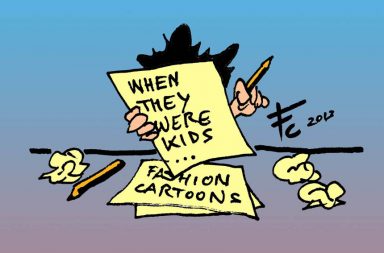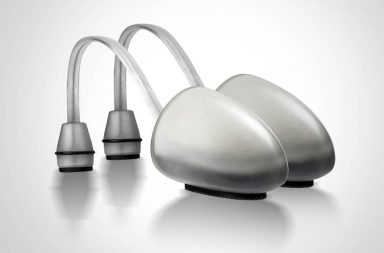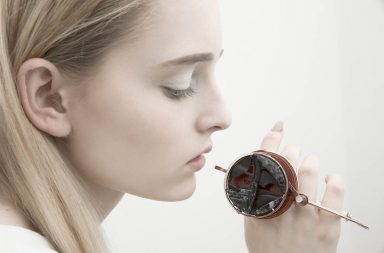At So Catchy! We think that if you’ve got a knack for design, it doesn’t matter what field you’re in. Carmela and Alfonso are a couple of architects (and a couple as well) who’ve decided to revolutionize the concept of artisanal footwear. Taking a cue from shoes made in Valverde del Camino, the Andalusian cradle of artisanal mastery as applied to the famous “botos” or boots, the sevillano couple have found a way to stay at the forefront of design while respecting the honesty of traditional ways of producing shoes in the southern Spanish town.

Carmela and Alfonso from Ray Garzía Shoes
A little less than a year ago, while visiting Barcelona, they decided to shake up their professional lives. At that time they hadn’t had any contact with the fashion world but Carmela and Alfonso discovered that the shoe was an object they could apply their creativity to. It was clear that the way forward wouldn’t be easy so they started with the basics. They became acquainted with the technical vocabulary, watched hours upon hours of YouTube videos detailing the manufacturing process and read anything they could get their hands on about moulds, leather and technique.
Ray Garzía Shoes are made completely by hand by the artisans of the Alfonso Senra Workshop in Valverde del Camino. The workshop has been producing shoes for more than a century and got its start making work boots. Carmela and Alfonso bring the leather (besides which they’ve used perch and Atlantic wolfish skin as well) and the heels made from olive trees from Jaén. They couldn’t be any more authentic.
This January they’ll be presenting their brand at the international fashion fair, Who’s Next? in Paris with a collection that we’ve had the pleasure of seeing from the beginning.
For us, getting to know them was an incredible treat and we were left with the feeling that if you just haven’t seen shoes until you’ve seen Ray Garzía Shoes.

SO CATCHY!: Two architects who decide to make shoes, where did the idea come from?
CARMELA: Our relationship with fashion was null. But as with any discipline that deals with design, it was interesting for us and it caught out attention as much as anything else, like furniture. It came about because, while in Barcelona, visiting with family, we started talking about shoes because, in the end, they are objects that can bring out a lot of creativity in many different ways.
ALFONSO: We go to shops together and we pay attention to the fabric, we turn it inside out to see how they’re sewn. We’ve always been attracted to the production behind fashion, the difference between one type of stitch and another, what is sewn well and how it affects the strength of fabric.
SC!: It seems that it was a natural process but you must have had to do some studying…
ALFONSO: Actually it was quite natural and in the end we didn’t have to change our working process very much. When we go to Valverde del Camino, it’s like visiting a building site, and then you head home and do the studio work, even the working hours are the same. The only difference is that instead of talking with engineers, we interact with the guy who sews the soles or the suppliers of the raw materials.
It’s pretty clear that from the moment we decided to design shoes it still took a few months to get to Valverde del Camino. We watched everything there is on YouTube about shoe manufacturing, we read everything we could about shoes and we talked to anyone who knew anything about the topic. How do you do this and that, we talked to people in Ubrique (Cádiz) about leather, etc. Once we knew the process and the technical vocabulary to be able to understand everything and communicate with the shoemakers, we set out. If we hadn’t done our research, they’d have laughed us out of the town.
CARMELA: In reality, footwear design and architecture have a lot in common; producing a shoe is a lot like putting up a building. We’ve talked about this a lot. When you’re in the design phase you’re already thinking about how the shoe will come together, you can’t say, “now we’re in the design phase and we don’t need to think about manufacturing”. You have to know the processes, the limitations of technology and labour, or the materials themselves. If you want to bring your designs to life, you need to be thinking from the beginning about the process and in that way both fields are quite similar.
SC! What was it like designing your first shoe?
CARMELA: We had to re-think everything from the shape on up. Valverde del Camino has been producing footwear forever but always using a specific form. Anyone who knows the Valverde ‘boto’ (boot) can see that the mould is always the same. It was quite difficult to find someone who was open to trying something new. Some shoemakers here in Seville also helped us with advice about how to change the moulds and what materials to use with specific moulds. From those moulds we began to design shoes and it was only later that we found out that most people do it that way.
ALFONSO: That happened at times when we made blueprints, you have to imagine and explain things that don’t exist in three dimensions yet. So we were able to apply that experience to footwear, which, a part from being a 3-dimensional object, has no symmetrical cuts at any point. It’s been really helpful when speaking with the people at the workshop.

SC!: Did you have a preconceived idea about a specific style, the design that Ray Garzía shoes was going to follow?
CARMELA: Not in the beginning, not at all. Our original idea was based on the shoes from Valverde, to understand how they were made, from the materials to the cuts and patterns, and once we understood that, we wanted to re-think everything. It’s a searching process, an experiment. And that’s how it began, looking at patterns and cuts, adding asymmetry. We wanted a shoe that showed the artisanal process, that was authentic, that had nothing to hide, with clear cuts, wood that looks and acts like wood, leather with the seams because we didn’t wanted to transform it. We like to say that we make honest shoes because you can see the process in the designs. They’re the result of an artisanal process, and the reinvention of the Valverde shoe.
SC!: What has been the most challenging part of launching your own line?
ALFONSO: The preparation. We spent months learning everything that we needed to know before even beginning to talk with professionals in the field. From basic shoemaking manuals to doctoral theses, video tutorials, interviews, technical dictionaries, etc.
SC!: What kind of reaction did you get from the workshop in Valverde when you came to them you’re your idea?
ALFONSO: Valverde has a very old tradition that comes from over a century of accumulated artisanal experience. The Valverde boto has never been stylish; it is a work boot. With that in mind, introducing a new perspective can be difficult, but if you meet the right people the sky is the limit.

SC!: Is there anything you look to for inspiration when designing, a part from the concept of reinventing Valverde footwear?
CARMELA: Yes, we’ve always thought about our homeland, Andalusia; the landscapes, the light and the material that we have in our memories. We’re also lucky to have a lot of contact with artists and artisans who give us a lot of inspiration.
As for the materials and the land, we feel quite comfortable letting our imaginations take flight with the work of noted expressionists like Kiefer, Barceló or Tápies.
SC!: What do you think that you bring to the world of footwear?
ALFONSO: We’ve only just begun, but we’d like to open up the possibilities of high-quality industrial artisanry such as that of Valverde. The possibilities are endless, and there’s so much to explore!
SC!: Who do you admire in the world of footwear? Any brands that speak to you?
CARMELA: It depends on what we’re analysing. You see, we are constantly looking at what other creatives are doing. We’ve already looked at more than one hundred brands that are making high-quality shoes. For example, Pep Monjo strikes us as an honest professional who makes simple, exquisite, almost perfect designs. Muñoz Vrandecic has a lot of passion and exceptional materials which he transforms into works of art with his hands. As for the upper crust, we admire the inexhaustible creativity of Alexander Wang. He just can’t stop coming up with new designs.
SC!: You’re betting on the quality of the materials and the artisanal handicraft and without a doubt you can see that in your shoes. What do you think is behind the trend in larger business towards a more artisanal style?
ALFONSO: Well, if they do it because they believe in it, we think it’s great. There is a growing trend in Western countries towards anything “slow”. But “slow” costs because there’s more involved in the process and it means more. There aren’t unstoppable machines behind it; there are people, families, neighbourhoods, and trade unions. If we want to maintain this treasure, then we should all seriously get behind it and be aware of the value of the work and the quality. If you’re only following the trend, then we’ll end up buying “slow-copies”.

SC!: You’ve said that you are always researching new ways to work with materials but how do you maintain the artisanal work and stay at the forefront of design at the same time?
CARMELA: We’ve got an agreement to work in Ubrique on elaborating our own line of finishes. We’re using state of the art technology there and we’re doing things like sand-blasting the hides to see what happens, adding oils, plant-based dyes, dirt, etchings and drawings. This should let us expand our horizons and allow us to offer a high level of exclusivity. In the first models, we’ve been working with a small tannery that prepares the hides however we want, specifically glazed and bound. Research is one of the pillars of Ray Garzía from the very beginning and it can be done, without a doubt, on the level of artisanry.
SC!: What do you value most about your partnership with the team at Senra?
CARMELA: Their experience and the family atmosphere.
SC!: Any websites or online magazines that you follow?
ALFONSO: We love Streetetiquette, Freundevonfreunden, Parkcube, TheSelby and ‘el blog de Patricia’…

SC!: You’ll be showing at Who´s Next in Paris, in the Première Classe soon, how do you feel?
CARMELA: It’s very motivating. We’re waiting patiently to hear the advice and comments of professionals in the field. We are also excited about being able to tell them about our work in person. We know that we need to promote the brand and this event could help us a lot.
SC!: Your favourite fictional character…
ALFONSO Y CARMELA: Robinson Crusoe
SC!: Why do you name your shoes after people?
ALFONSO: We spend so much time with them that it’d be rude not to! (laughs)
Photos courtesy of Lourdes Rodríquez and Ray Garzía Shoes
Translation and Layout by Michael Padilla




